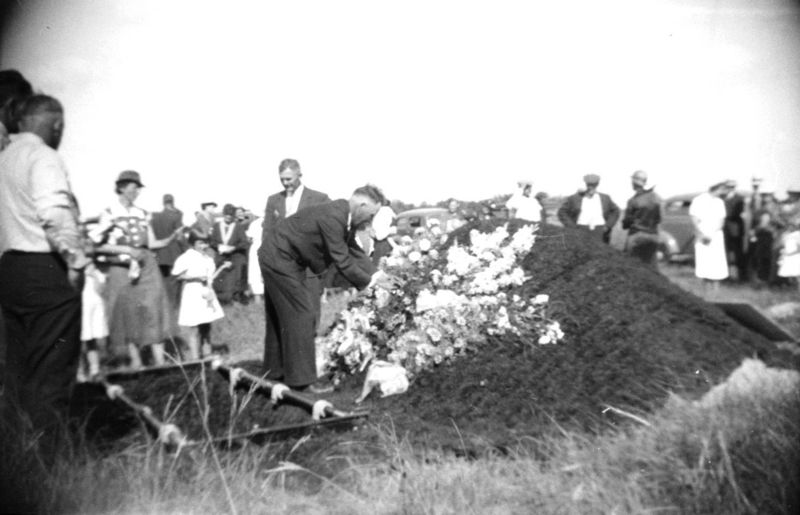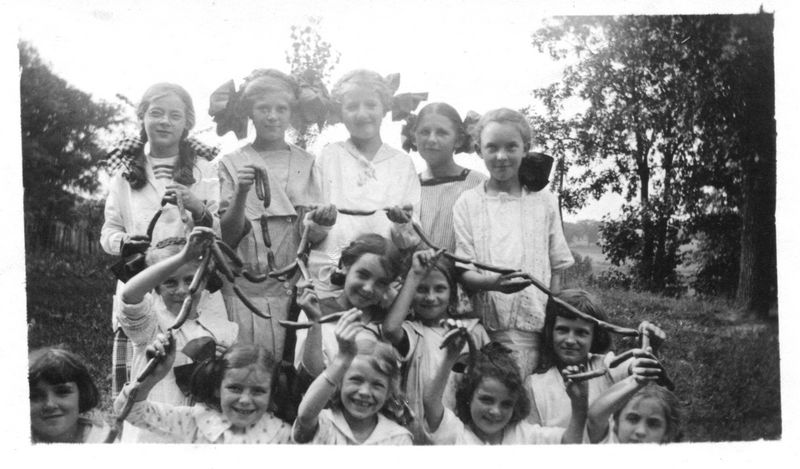 |

| |
|
|  |
A Sea Of Hats: Farm Foreclosure Sale
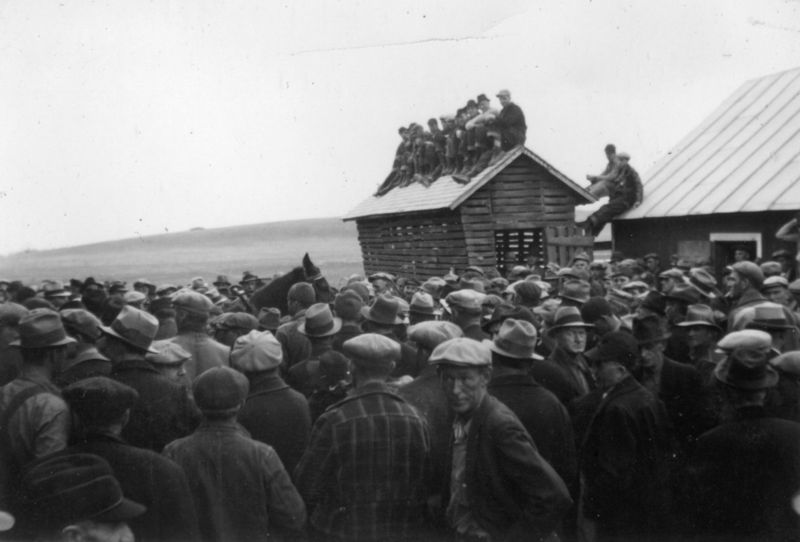 This image This image, one of two captioned "At Uncle Nick's Auction," shows a common sight around the rural USA during the 1930s. No, not just a crowd of fedoras and paperboy hats (although those were quite common, especially at the employment office or the bread lines). Farm foreclosures were driven by the Great Depression, a sluggish economy, a prewar slump due to foreign instability, and the ongoing change from a raw-materials economy to a manufacturing economy. This one appears to have been taken in 1938, after the "heyday" of foreclosures in the early 1930s. Early on, farmers protested and caused 'penny auctions' -- friends and neighbors ran off genuine bidders, and never bid more than a penny for any lot. By the late 1930s the worst of it was over, some economic reforms were starting to help, and this auction was probably handled better than frantic bank-recoveries earlier in the decade. Also: farmer's diary * iowa depression * nebraska foreclosures * remembering farm life Labels: 1930s, 1938, antique photo, farm life, wisconsin history
More Cranky Kids
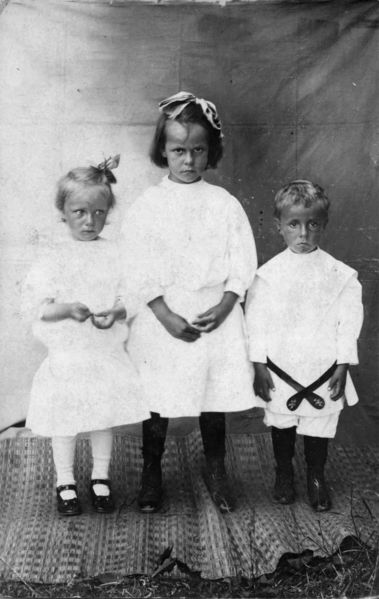 I'm not sure how these children relate to the grumps in this photo from last week, But they seem to share a venue and photographer. It's the same (or very similar) venue, a folded sheet of some sort hung as a backdrop, with a dirt floor. The kids' footing is improved by adding a reed mat on the ground for this photo, but it didn't improve the children's attitudes. Little Gunther looks like he's about to cry, and the photographer is lucky Marta can't actually start fires with her mind even though she's trying really, really hard. The style of dress is of a similar period as the previous photo, but a bit more formal: all white may signify some religious event is taking place (baptism, first communion, etc.), or it could be that their church-clothes are the nicest outfits they have to put on for a photographer. Labels: 1900s, antique photo, clothing, kids
1930s Nicknames
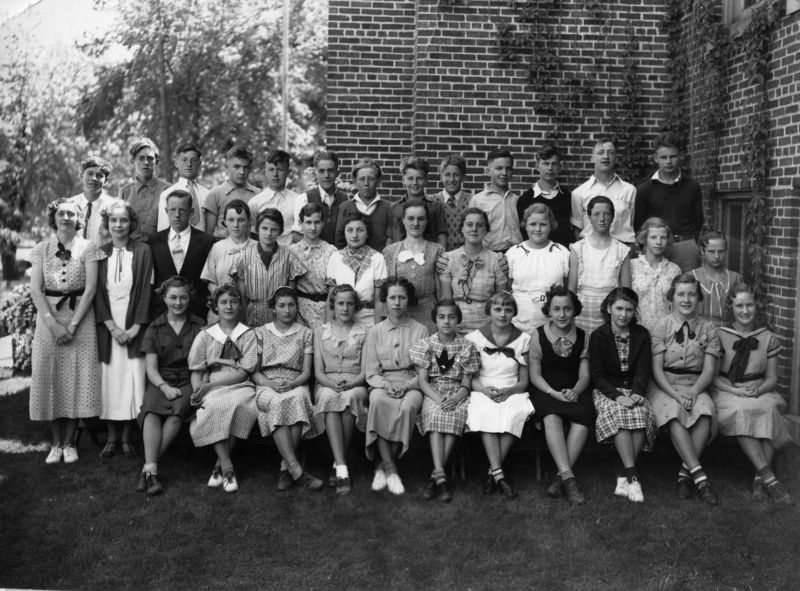 High school -- a time of nicknames and rivalries no matter when you were born. This photo, from a photo-album of the late 1930s, has some evidence on the front. That girl in the front row in white -- right in the middle -- has her eyes blacked-out with pencil (you can see it in the large version). On the back were, presumably, well-wishes from student's friends, names written in the hand of the signer. Underneath the photo, written on the page in the photo album, are a clearer picture of the students identities: "Bruno", "Giggling Gertie", "Ossie" -- and I think that's just the girls. Labels: 1930s, 1938, antique photo, high school, notes
Cranky, Cranky Kids
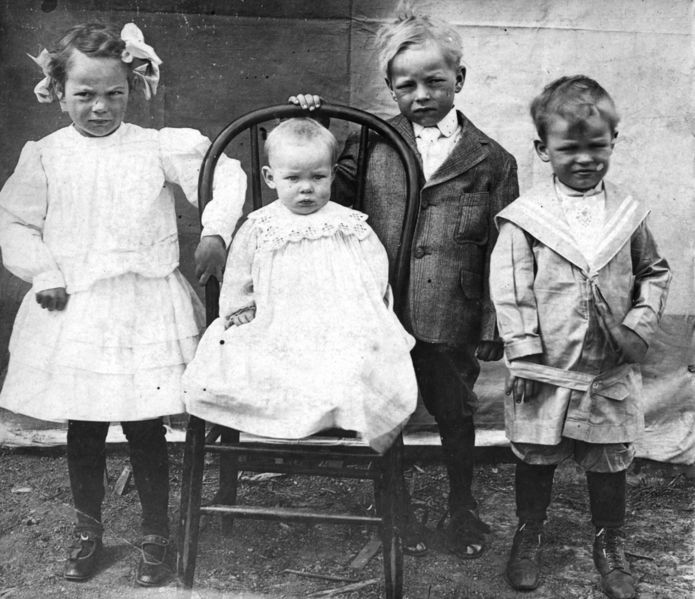 Oh, my -- I know kids hate to get dressed up, but the dress clothes of today pale in comparison to the kids of the early 1900s. That sailor suit on the right? It would cause a riot among modern kids. The photo appears to me to be from a travelling photographer; the ground is dirt and grass, the chair is simple (probably recruited from the nearest building), and the backdrop is simple. Despite the outdoors, the camera is of a vintage without a speedy shutter, resulting in some blurriness. It could, however, also be an attempt to emulate a more expensive photo studio by hanging a sheet over the washline and getting the kids dressed up to the tees. Either way, the kids weren't happy about it. see also: edwardian kids clothes * poor during Progressive era * progressivism and childrenLabels: 1900s, antique photo, fashion, kids
Three Gents in Snappy Hats
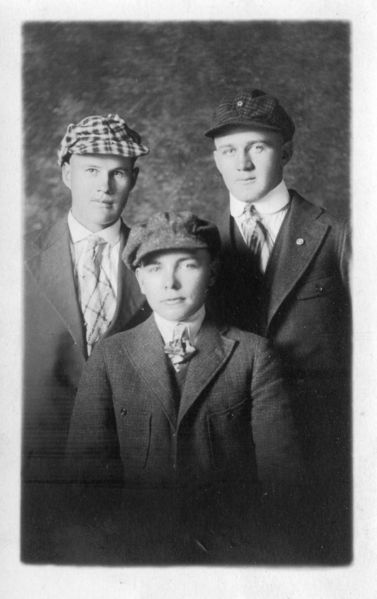 What's these guys' stories? Sometime in the 1910s, maybe twenties, three lads got together for a group shot -- and it must've been important that they be wearing hats. The style of hat is called a 'newsboy', 'Gatsby' hat, or driving cap, and was popular with the trendy kids of the early 20th century. The button-close breast pockets on the two gents on the right has a very military feel to it, and echoes the late 19th century. The lad on the left shops at a different tailor: sans vest, modern shirtcollar, his collar is lower, wider below the collar on the notched lapel, and is missing the breast pockets. Maybe he's older, and doesn't rely on Mom to do his clothes-shopping. Any which way, they're a sharp looking group of guys. Labels: 1910s, antique photo, clothing, men, suit
Steampunk Joker
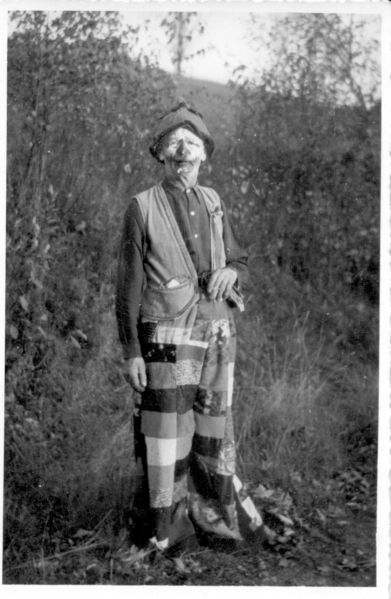 The new Joker The new Joker looks surprisingly like this artifact of the last century. This comedic entertainer certainly looks a bit past his prime -- although, he could just be worn out from his show. The makeup is smeared and worn off, and if you look really close you'll see a cigarette in his fingers. This was purchased from a travelling dealer here in Fargo, so I don't know where the funnyman is from. The hobo is usually an American style, so I doubt he's from abroad. Hopefully he stuck to clowning, and didn't run afoul of any batmen. Labels: antique photo, clown
Armour Stockyards, West Fargo ND, 1938
The Troublemakers
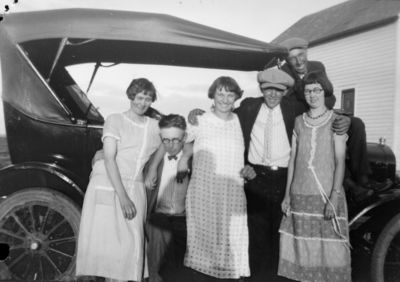 These are the Troublemakers -- I only call them that because they look like those reckless teens that were only out to start trouble. You know, the ones that listened to jazz and watched boxing and didn't give a horse's patootie about what their fathers had to deal with, what with fighting the Kaiser overseas and living through flu epidemics. These reckless children of the 1920s couldn't have been all that bad, though; these are from the set of Minnesota farm life negatives that I've been scanning over the past year. These kids grow up, move to exotic places like Revere, Minnesota, and have troublesome kids of their own. Labels: antique photo, early 20th century farm photos
4Hers Take Over Moorhead, Minnesota: 1961
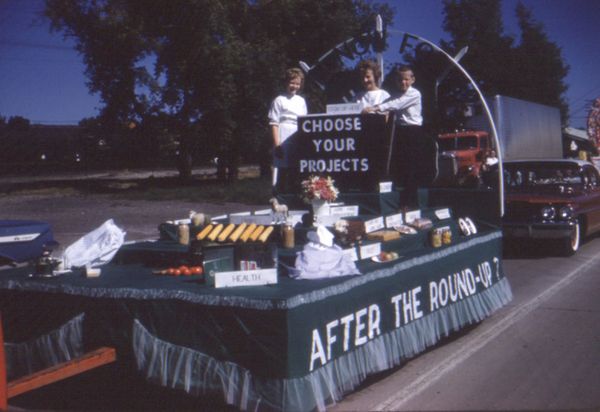 In the summer of 1961, 4H-ers from all over Clay County, Minnesota, converged on Moorhead for a parade and a Round-Up. Not exactly the County Fair (that's held in Barnesville), it was a chance for local farm kids to head into the big city and show off their skills. These photos were taken along Center Avenue, standing in front of what's now a vacant car dealership just east of 9th Avenue. The photos focus on the floats -- sadly, very backlit -- but there's a few photos from the Round-Up. I do not know the photographer; the focus given to the Oak Mount float would lead me to believe that the family is from Kragnes, a few miles up the road from Moorhead (although in the past 50 years Moorhead has encroached close to Kragnes' borders; if I were a mall developer, that's where I'd buy land). My dad was in 4H a few years later. At 6 years old he was still a bit young for this parade; these kids would be in their 60s today. Labels: 4h, antique photo, clay county history, minnesota history
Charles Baxter, in his vestments
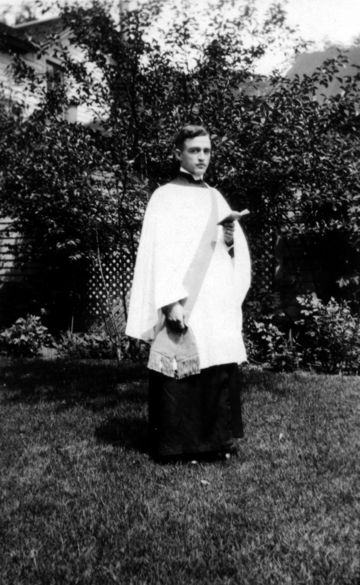 Unfortunately for Mr. Baxter, he's got too common a name for me to reliably track him down. Most photos are from the Winona, Minnesota area, so I'm fairly certain Charles hails from there. This photo of Charles, in his vestments, was taken in 1916 (as was one of him out of vestments), so my guess is he was born in the 1890s -- he's probably not around anymore, sadly. The back of the photo indicates he's wearing his "vestments", consisting of an unadorned white chasuble over a black alb or cassock, with a light-colored fringed stole with the Cross Pattée embroidered at the ends. Having the stole draped to the side would indicate that Charles hasn't completed his ordination yet -- it's worn symmetrically by ordained priests & ministers usually. His book is rather thin, and is probably a prayer-book. Vestments are similar between the various Christian lines, so I can't decisively identify his church. Still, I hope he continued his education, and got his stole moved to the center. Labels: antique photo, minnesota history, religious photo
18 Miles To Norfolk
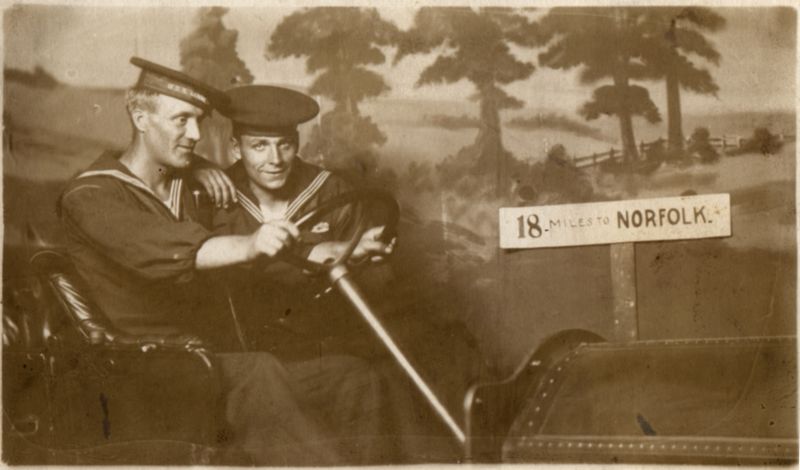 We're going to Norfolk! My guess is that these sailors were on the way to Norfolk Naval Base in Virginia, ready to work on the steel-clad steamships that dominated the US Navy in the earliest parts of the 20th century. Given the style of car and the uniforms, Norfolk was probably a short stop: World War I was probably the ultimate destination for these lads. Labels: antique photo, automobilia, military
Brick Building By the Railroad Tracks
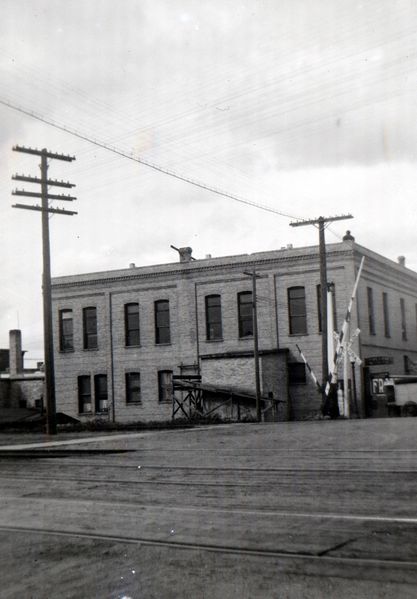 The back of a nicely-made brick building, in an unknown town. Excellent brickwork, ball finial at the corner, backing the railroad -- but no identifying signs on this site. I did my best, scanning and rescanning at highest resolution, using PShop tricks to try and coax out the words on the overhang, on the far right side, with no luck. It's just not readable. I know I called it an 'old brick building' in the filename, but it was definitely not old at the time of the photo: taken in the 1920s or 1930s, it was probably 30 years old, at the most -- if it still stands, it's around its 100th birthday these days. [more]Labels: antique photo, historical buildings, minnesota history, red album
Minnesota Kaiser - 1947
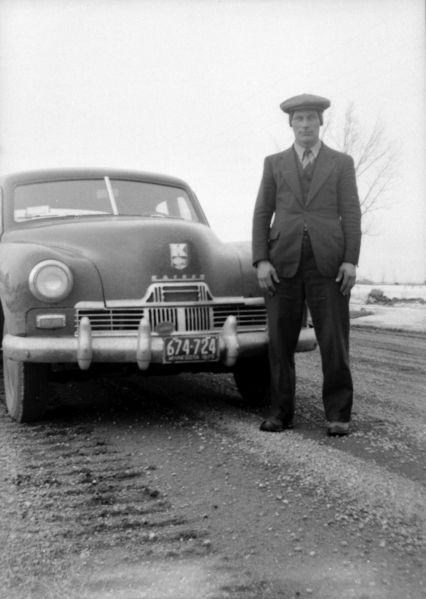 My great-uncle (not the guy in the picture) had a Kaiser Frazer -- he owned it until he needed to clear out his farmstead, at which time the Frazer moved out to my uncle's farm, where it has sat for almost twenty years now, progressively and slowly turning into a pile of rusty dust. Kaiser wasn't a big manufacturer, and there weren't a lot around, so I was rather surprised to turn up a whole bunch of pictures of another Kaiser taken within twenty miles of where my great-uncle lived. How'd that happen? Grandpa Vernon, as always, had the answer: there was a Kaiser dealer out that way, so there was ample opportunity for local farmers to buy 'em. In the post-war booming, accompanied by REA, improved roads and transportation, and new farming techniques, farmers did pretty good for themselves, plenty enough to warrant spending a bit on a nice new car. So, as you might have noticed, I've been scanning and uploading more of my Early 20th Century Minnesota Farmland series -- if I were more organized, I could point out the new ones better, but, sadly, there's just so many of them. New images are primarily the last 1/4 of the Black Album, and all of the Red Album. Labels: antique photo, farming, frazer, kaiser, minnesota, photos
Girls With Their Long Wieners
|  |
|
|
 This image, one of two captioned "At Uncle Nick's Auction," shows a common sight around the rural USA during the 1930s. No, not just a crowd of fedoras and paperboy hats (although those were quite common, especially at the employment office or the bread lines). Farm foreclosures were driven by the Great Depression, a sluggish economy, a prewar slump due to foreign instability, and the ongoing change from a raw-materials economy to a manufacturing economy. This one appears to have been taken in 1938, after the "heyday" of foreclosures in the early 1930s. Early on, farmers protested and caused 'penny auctions' -- friends and neighbors ran off genuine bidders, and never bid more than a penny for any lot. By the late 1930s the worst of it was over, some economic reforms were starting to help, and this auction was probably handled better than frantic bank-recoveries earlier in the decade.
This image, one of two captioned "At Uncle Nick's Auction," shows a common sight around the rural USA during the 1930s. No, not just a crowd of fedoras and paperboy hats (although those were quite common, especially at the employment office or the bread lines). Farm foreclosures were driven by the Great Depression, a sluggish economy, a prewar slump due to foreign instability, and the ongoing change from a raw-materials economy to a manufacturing economy. This one appears to have been taken in 1938, after the "heyday" of foreclosures in the early 1930s. Early on, farmers protested and caused 'penny auctions' -- friends and neighbors ran off genuine bidders, and never bid more than a penny for any lot. By the late 1930s the worst of it was over, some economic reforms were starting to help, and this auction was probably handled better than frantic bank-recoveries earlier in the decade. 
















